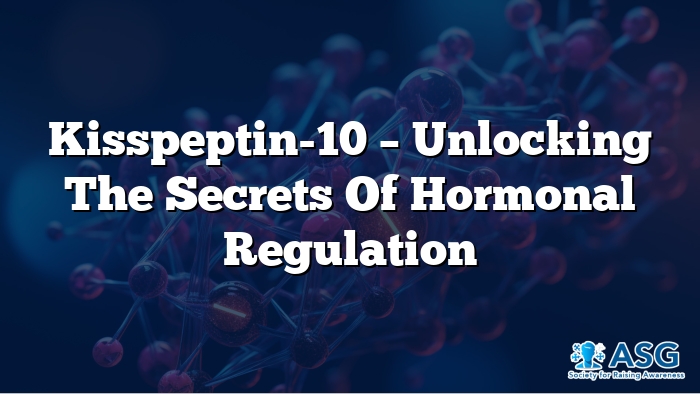Kisspeptin-10 – Key to Hormonal Regulation or More Hype?

Kisspeptin-10 has emerged as a critical peptide in reproductive health and endocrine regulation. This bioactive molecule, derived from the larger kisspeptin protein encoded by the KISS1 gene, has captured the attention of researchers and healthcare professionals alike. Its pivotal role in puberty onset and hormonal balance makes it a subject of intense study and potential therapeutic applications.
What is Kisspeptin-10?
Kisspeptin-10 is a 10-amino acid peptide fragment of the kisspeptin protein. Produced in the hypothalamus, it binds to the GPR54 receptor, initiating a cascade of events crucial for reproductive functions.
This bioactive peptide is essential for stimulating the release of gonadotropin-releasing hormone (GnRH), which in turn regulates the production of luteinizing hormone (LH) and follicle-stimulating hormone (FSH).
The Role in Puberty
The onset of puberty is intricately linked to Kisspeptin-10. As levels of this peptide increase, it triggers the release of GnRH, setting in motion the development of secondary sexual characteristics. Disruptions in the kisspeptin-GPR54 pathway can lead to delayed or absent puberty, underscoring the importance of this peptide in sexual maturation.
Influence in Reproductive Health
Kisspeptin-10's influence on reproductive health is profound. In males, it regulates testosterone production and spermatogenesis. In females, it plays a crucial role in follicular development and ovulation. Abnormalities in Kisspeptin-10 signaling can result in various reproductive disorders, including infertility and polycystic ovary syndrome (PCOS).
Mechanisms of Action
The action of Kisspeptin-10 is mediated through its binding to the GPR54 receptor. This interaction activates the phospholipase C (PLC) pathway, leading to the production of inositol triphosphate (IP3) and diacylglycerol (DAG). These molecules facilitate calcium ion release, crucial for GnRH secretion.
Impact on Fertility
Fertility is significantly influenced by Kisspeptin-10. Its regulation of GnRH release directly impacts the production of LH and FSH, hormones essential for gamete maturation and menstrual cycle regulation. Peptide clinics and researchers are exploring its potential in treating infertility and other reproductive disorders.
Regulation of Hormones by Kisspeptin-10
Kisspeptin-10's role in hormone regulation is complex and far-reaching. By stimulating GnRH release, it indirectly controls the production of sex hormones. This intricate regulatory mechanism highlights the peptide's importance in maintaining hormonal balance and reproductive health.
Clinical Applications of Kisspeptin-10
The potential clinical applications of Kisspeptin-10 are diverse. It shows promise in treating delayed puberty, hypogonadism, and infertility. Moreover, research indicates its potential in oncology, particularly in inhibiting cancer metastasis.
Peptide manufacturers are keenly interested in developing Kisspeptin-10 based therapies.
Potential Side Effects
While Kisspeptin-10 holds therapeutic promise, potential side effects must be considered. Overstimulation of the gonads can lead to complications such as ovarian hyperstimulation syndrome (OHSS) in females and testicular enlargement in males. Peptide safety protocols are crucial in mitigating these risks.
Kisspeptin-10 vs Other Hormonal Regulators
Kisspeptin-10 stands out among hormonal regulators due to its direct action on the hypothalamus. Unlike gonadotropins that act downstream, Kisspeptin-10 initiates the hormonal cascade at its source, making it a potent and specific regulator of reproductive functions.
Research Studies
Numerous studies have explored Kisspeptin-10's role in reproductive health. Research has demonstrated its ability to stimulate GnRH release and regulate LH and FSH production. Ongoing studies are investigating its potential in treating various reproductive disorders and certain cancers.
Effect on Hypothalamus
Kisspeptin-10's primary site of action is the hypothalamus. By binding to GPR54 receptors on hypothalamic neurons, it stimulates GnRH release, initiating the reproductive hormone cascade. This mechanism underscores the peptide's crucial role in maintaining the hypothalamic-pituitary-gonadal axis.
Therapeutic Uses
The therapeutic potential of Kisspeptin-10 is vast. It shows promise in treating delayed puberty, hypogonadism, and infertility. Additionally, its ability to inhibit cancer metastasis opens up possibilities in oncology. Peptide sciences are actively exploring these therapeutic avenues.
Genetic Factors
Genetic factors play a significant role in Kisspeptin-10 levels. Mutations in the KISS1 gene can lead to abnormalities in kisspeptin production, resulting in reproductive disorders. Understanding these genetic influences is crucial for developing targeted therapies.
Future Directions
Future research on Kisspeptin-10 is likely to focus on its therapeutic applications and safety profile. Advancements in genetic research will provide deeper insights into its regulation and function. Peptide synthesis techniques will be crucial in developing novel Kisspeptin-10 based therapies.
Understanding Kisspeptin-10 Receptors
The GPR54 receptor is key to Kisspeptin-10's function. Understanding its structure and function is essential for developing targeted therapies. Research into receptor modulation could lead to new approaches in treating reproductive disorders.
| Key Points | Description |
|---|---|
| Function | Stimulates GnRH release, regulates reproductive hormones |
| Clinical Applications | Treatment of infertility, delayed puberty, potential cancer therapy |
| Mechanism | Binds to GPR54 receptor, activates PLC pathway |
| Safety Considerations | Potential for ovarian hyperstimulation, testicular enlargement |
Conclusion
Kisspeptin-10 plays a pivotal role in reproductive health and puberty onset. Its ability to regulate GnRH release makes it a powerful modulator of the reproductive system. While its therapeutic potential is promising, careful consideration of safety and efficacy is crucial. As research progresses, Kisspeptin-10 may revolutionize treatments for reproductive disorders and potentially contribute to cancer therapies.
Frequently Asked Questions
What is the primary function?
Kisspeptin-10 primarily stimulates GnRH release, regulating reproductive hormone production.
Can Kisspeptin-10 be used to treat infertility?
Yes, Kisspeptin-10 shows promise in treating infertility by regulating reproductive hormone levels.
Are there any side effects?
Potential side effects include ovarian hyperstimulation and testicular enlargement. Careful monitoring is essential.
